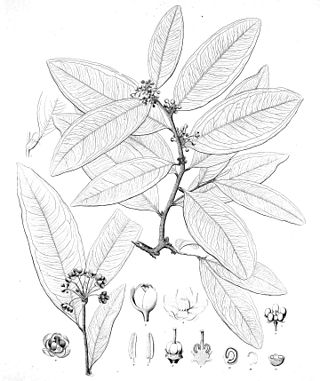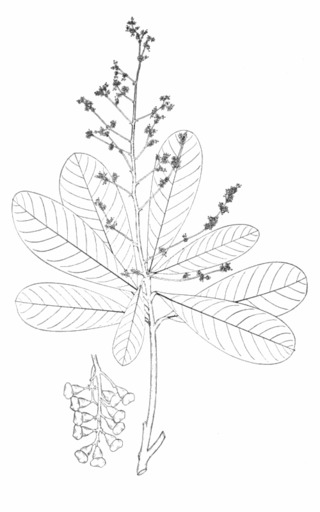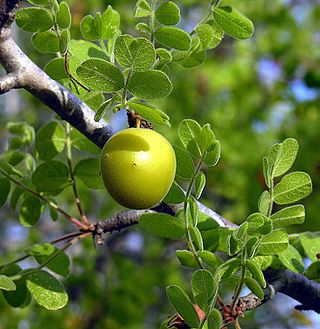
Brackenridgea is a plant genus of about 10 species in the family Ochnaceae. The genus is named for the British-American botanist William Dunlop Brackenridge.
Canarium sarawakanum is a tree of Borneo in the incense tree family Burseraceae. The specific epithet sarawakanum is from the Latin, referring to the species being native to Sarawak.

Euthemis is a genus of plant in the family Ochnaceae. The generic name is from the Greek meaning "good law", referring to the even thickness and symmetry of the leaves.
Heliciopsis is a genus of about thirteen species of trees, constituting part of the flowering plant family Proteaceae. They grow naturally in Burma, Indo-China, SE. China, Thailand, Peninsular Malaysia, Borneo, Sumatra, Java (Indonesia) and the Philippines. The name means similar to the plant genus Helicia. Its closest relatives are Athertonia (Australia) and Virotia.
Canarium denticulatum is a tree in the family Burseraceae. The specific epithet denticulatum is from the Latin meaning "small teeth", referring to the leaf margin.
Schuurmansiella is a monotypic genus of plant in the family Ochnaceae. As of June 2014 The Plant List recognises the single species Schuurmansiella angustifolia. The specific epithet angustifolia is from the Latin meaning "narrow leaf".
Androtium is a monotypic genus of trees in the cashew or sumac family Anacardiaceae. It contains the single species Androtium astylum. The generic name Androtium is from the Greek meaning "male ear-lobe", referring to the shape of the lobe of the stamen. The specific epithet astylum is from the Latin meaning "without style", referring to the plant's ovary.
Buchanania insignis is a tree of Borneo in the cashew and sumac family Anacardiaceae. The specific epithet insignis is from the Latin meaning "remarkable".
Buchanania sessilifolia is a tree in the family Anacardiaceae. The specific epithet sessilifolia is from the Latin meaning "leaf without stalk", referring to the sessile leaves.
Buchanania splendens is a tree in the family Anacardiaceae. The specific epithet splendens is from the Latin meaning "shining", referring to the leaves.
Campnosperma squamatum is a tree in the cashew and sumac family Anacardiaceae. The specific epithet squamatum means "scaly", referring to the leaf surface.
Dracontomelon costatum is a tree in the cashew and sumac family Anacardiaceae. The specific epithet costatum means "ribbed", referring to the leaf veins.
Drimycarpus maximus is a tree of Borneo in the cashew and sumac family Anacardiaceae. The specific epithet maximus means "greatest", referring to the large leaves and fruits.
Gluta laxiflora is a tree of Borneo in the cashew and sumac family Anacardiaceae. The specific epithet laxiflora is from the Latin meaning "loose flowers", referring to the arrangement of the flowers.
Gluta rugulosa is a tree of Borneo in the cashew and sumac family Anacardiaceae. The specific epithet rugulosa is from the Latin meaning "wrinkled", referring to the fruits.
Gluta sabahana is a tree of Borneo in the cashew and sumac family Anacardiaceae. The specific epithet sabahana is from the Latin meaning "of Sabah".

Gluta velutina is a plant of tropical Asia in the cashew and sumac family Anacardiaceae. The specific epithet velutina is from the Latin meaning "velvety", referring to the inflorescences.

Semecarpus cuneiformis is a tree in the cashew and sumac family Anacardiaceae. The specific epithet cuneiformis is from the Latin meaning "wedge-shaped", referring to the leaf base.

Holigarna is a genus of trees in the subfamily Anacardioideae of the cashew and sumac family Anacardiaceae. They grow naturally in India, Bangladesh and Indo-China. This is a poisonous tree; if contacted, it would irritate skin chemically and result in irreversible skin damage. Smoke from burning this wood is dangerously disabling.

Cyrtocarpa is a genus of trees in the subfamily Spondiadoideae of the cashew and sumac family Anacardiaceae. Their habitat is dry forests to open arid areas. They grow naturally in Mexico and northern South America.





